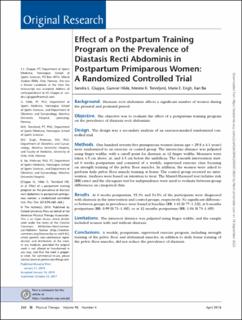| dc.contributor.author | Gluppe, Sandra L. | |
| dc.contributor.author | Hilde, Gunvor | |
| dc.contributor.author | Tennfjord, Merete Kolberg | |
| dc.contributor.author | Engh, Marie Ellström | |
| dc.contributor.author | Bø, Kari | |
| dc.date.accessioned | 2023-10-12T13:17:29Z | |
| dc.date.available | 2023-10-12T13:17:29Z | |
| dc.date.created | 2018-02-01T07:56:41Z | |
| dc.date.issued | 2018 | |
| dc.identifier.citation | Physical Therapy. 2018, 98(4), Side 260-268. | en_US |
| dc.identifier.issn | 0031-9023 | |
| dc.identifier.uri | https://hdl.handle.net/11250/3096167 | |
| dc.description | This is an Open Access article distributed under the terms of the Creative Commons Attribution-NonCommercial-NoDerivs licence (http://creativecommons.org/licenses/by-nc-nd/4.0/), which permits non-commercial reproduction and distribution of the work, in any medium, provided the original work is not altered or transformed in any way, and that the work is properly cited. | en_US |
| dc.description.abstract | Background: Diastasis recti abdominis affects a significant number of women during the prenatal and postnatal period.
Objective: The objective was to evaluate the effect of a postpartum training program on the prevalence of diastasis recti abdominis.
Design: The design was a secondary analysis of an assessor-masked randomized controlled trial.
Methods: One hundred seventy-five primiparous women (mean age = 29.8 ± 4.1 years) were randomized to an exercise or control group. The interrectus distance was palpated using finger widths, with a cutoff point for diastasis as ≥2 finger widths. Measures were taken 4.5 cm above, at, and 4.5 cm below the umbilicus. The 4-month intervention started 6 weeks postpartum and consisted of a weekly, supervised exercise class focusing on strength training of the pelvic floor muscles. In addition, the women were asked to perform daily pelvic floor muscle training at home. The control group received no intervention. Analyses were based on intention to treat. The Mantel-Haenszel test (relative risk [RR] ratio) and the chi-square test for independence were used to evaluate between-group differences on categorical data.
Results: At 6 weeks postpartum, 55.2% and 54.5% of the participants were diagnosed with diastasis in the intervention and control groups, respectively. No significant differences between groups in prevalence were found at baseline (RR: 1.01 [0.77–1.32]), at 6 months postpartum (RR: 0.99 [0.71–1.38]), or at 12 months postpartum (RR: 1.04 [0.73–1.49]).
Limitations: The interrecti distance was palpated using finger widths, and the sample included women with and without diastasis.
Conclusions: A weekly, postpartum, supervised exercise program, including strength training of the pelvic floor and abdominal muscles, in addition to daily home training of the pelvic floor muscles, did not reduce the prevalence of diastasis. | en_US |
| dc.language.iso | eng | en_US |
| dc.subject | pelvic health | en_US |
| dc.subject | physical therapy | en_US |
| dc.title | Effect of a postpartum training program on the prevalence of diastasis recti abdominis in postpartum primiparous women: A randomized controlled trial | en_US |
| dc.type | Peer reviewed | en_US |
| dc.type | Journal article | en_US |
| dc.description.version | publishedVersion | en_US |
| dc.rights.holder | © The Author(s) 2018 | en_US |
| dc.source.pagenumber | 260-268 | en_US |
| dc.source.volume | 98 | en_US |
| dc.source.journal | Physical Therapy | en_US |
| dc.source.issue | 4 | en_US |
| dc.identifier.doi | 10.1093/ptj/pzy008 | |
| dc.identifier.cristin | 1560123 | |
| dc.description.localcode | Institutt for idrettsmedisinske fag / Department of Sports Medicine | en_US |
| cristin.ispublished | true | |
| cristin.fulltext | original | |
| cristin.qualitycode | 2 | |
